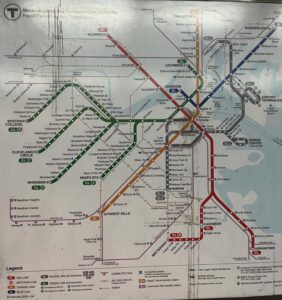
Used to be, a fella could regale his buddies with endless tales of his bravery and fortitude in the face of adversity — of mettle in battle, for instance, or stamina on a Grand Teton ascent, or resolve in the face of a cattle stampede. Around the turn of the century, though, these kinds of exploits became fewer and farther between. In the citified Northeast, in particular, the cattle stampedes were thinning out, the mountains were being graded and paved, and the battlefields were a world away. The chance to test and then tell of one’s spunk was vanishing. For all practical purposes, it looked like true grit and character-building were about to go the way of the powdered wig.
And then came the T. There is something deceptively, soothingly benign about the T until you know it well. It’s old (the Park-to-Boylston stretch, opened in 1896, is the oldest subway tunnel in this hemisphere). It’s small and bumbling; its branches are named after crayons; and it has stops with fantastic designations such as Wonderland and Maverick and St. Mary’s and Museum. It has little green trolley cars. It lumbers. It creaks.
But that kindly facade quickly falls away. As any trusting galoot who has ever traversed one of the T’s 196.5 miles can tell you, riding the subways and light-rail vehicles of the Massachusetts Bay Transit Authority is a test of pluck the likes of which the modern world has never seen. For sheer speed, reliability, and logic–or, more exactly, the lack thereof — the T has no equal. Suffice it to say that the T is simply awful. It is, in fact, our battle, our Teton, and our runaway cattle all in one.
Like those legendary challenges, the T inspires amazing stories–standard fixtures in any proper Bostonian conversation. Whether by accident or act of collective unconscious, the stories are formed by the same themes that shape all great adventure tales: unbearable heat (“It was 95 degrees outside, and the Red Line had the heat on full blast!!”); paralyzing cold (“It must have been 10 below zero, and the Arborway air conditioning was going full blast!!”); superhuman endurance (“I must have stood at Forest Hills for two hours!!”); and utter chaos (“the Blue Line was so crowded that people were piled to the ceiling!!”).
And as is the case in all tests of backbone, there is an undercurrent of rivalry among T riders about who puts up with the most abuse and thus deserves to spin the most astonishing yarn. More than half a million people ride the T each day, so the undercurrent is practically a tidal surge. Red Line riders, who are sure they have it the worst, bemoan their years of tolerating construction and breakdowns. Green Line riders, who are sure they have it the worst, point to their faulty light-rail vehicles, their road-level tracks, their overcrowded cars. Blue Line riders, who are sure they have it the worst, note that everyone going to the airport overloads their line. Orange Line riders, who are sure they have it the worst, say the only reason their line is being relocated is because the MBTA agrees it is the worst. Arborway riders, who really do have it the worst, are usually too busy chasing trolleys to say much at all.
Will the great tradition of Terrible T Tales ever end? It’s doubtful: The T may be building snazzy new stations and improving service, but it can’t beat decades of devoted traditionalists who’ve made telling tales of honor and bravery and ennobled suffering on the T a classic New England folk art. Unless, of course, some clever manager at the T considers reinstating the cattle stampede.